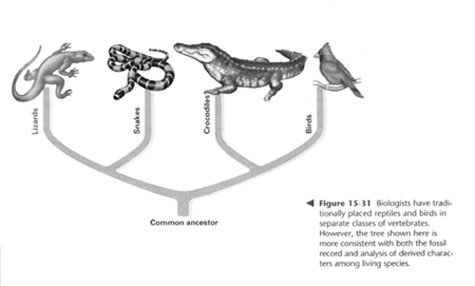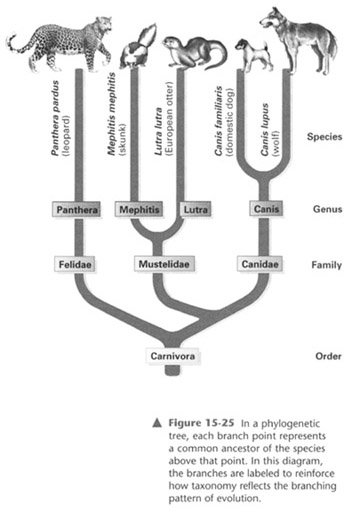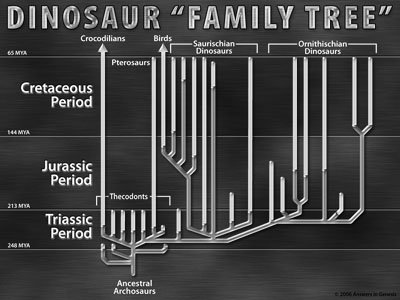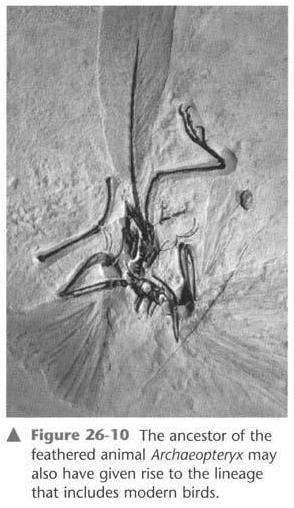
Chapter 2
Classifying Life
Classification systems are used to help us organize and study living things.
Then God said, “Let the earth bring forth grass, the herb that yields seed, and the fruit tree that yields fruit according to its kind, whose seed is in itself, on the earth”; and it was so. And the earth brought forth grass, the herb that yields seed according to its kind, and the tree that yields fruit, whose seed is in itself according to its kind. And God saw that it was good.—Genesis 1:11–12
What You Will Learn
There are many different ways to group living things depending on the presuppositions that you start with.
Classification systems are used to help us organize and study living things. There are many different ways to group living things depending on the presuppositions that you start with. Evolutionists believe that all living things descended from a single common ancestor. Because they have this presupposition, they use the differences in physical traits, DNA, and protein sequences to determine relationships among different kinds of animals and plants. This assumption of a common ancestor has forced evolutionists to reorganize many of the original classifications of animals. Dinosaurs are now believed to be the ancestors of birds. Some have even suggested reclassifying birds as reptiles since the molecular evidence is interpreted to support this claim. The classification of the apes, among which evolutionists include humans, has changed to reflect the evolutionary view that humans are just intelligent apes. Some have even gone so far as to suggest that chimpanzees be included in the human genus Homo.
The Bible tells us that man was created in the image of God, and therefore man should not be classified as an ape. Creationists, starting from the truth found in the Bible, classify living things into distinct “kinds” and recognize the amazing genetic variety found within each kind. The field of baraminology involves studying the classification of living things through the biblical concept of the created kinds. The molecular evidence of proteins and DNA can be used to understand relationships within the created kinds, but it can’t be used to understand how one kind changed into another, because that type of change has never occurred. Evolutionists will not arrive at an accurate understanding of the relationships of living things because their starting assumptions do not reflect the absolute truth available in God’s Word.
What Your Textbook Says about Classifying Life
| Evolutionary Concept | Glencoe | PH-Campbell | PH-Miller | Holt | Articles |
|---|---|---|---|---|---|
| Linnaeus develops a system for classification. | 444 | 341 | 448–449 | 300 | 2:1 |
| Classification is based on evolutionary relationships and physical traits. | 442 | T7, 341 | 452–453, 457 | T298 | 2:2 |
| Classification uses cladograms and phylogenetic trees to interpret and describe evolutionary relationships. | 445, 452 | 345–348, T345 | 453, 458, T458 | 310 | 2:3, 2:4 |
| Homologous and analogous structures are used to determine evolutionary relationships. | 444 | — | 384, T453 | 305, 594 | 3:6, 3:7, 3:29 |
| Dinosaurs are the ancestors of modern birds. Birds are actually closely related to alligators. | 445, 452–453 | 345–348, T346, T558, T561, 564, 568 | 432, 799, 807, T807 | 307– 309, 727, T787 | 2:5, 2:6, 2:7, 3:35 |
| All life on earth came from a single common ancestor. | 454–455 | — | 382, T382– T383, T385, 410, T418, 457, 460–461 | 413 | 3:6, 3:7, 3:8, 3:13, 3:19 |
| Evolutionary relationships can be determined by comparing DNA and amino acid sequences. Evolutionary time can be measured with molecular clocks. | 462 | T303, 341, 343, T343–T344 | 451, 454, T454, 455, T455 | 220, 232, 413, 602, 737 | 2:8, 3:6, 3:29 |
Note: Page numbers preceded by “T” indicate items from the teacher notes found in the margins of the Teacher’s Edition.
What We Really Know about Classifying Life
Genesis records that God created the animals and plants according to their kind. Genesis explains that God created specific kinds of animals. These kinds were able to breed and reproduce more of the same kind with a great variety of traits. It is not absolutely clear what the boundaries of the original kinds were, but it is clear from Genesis that the different animals and plants did not evolve from one another. The creation of life on earth was certainly a miraculous event that man will never be able to fully understand—it must be accepted by faith. However, it requires just as much—if not more— faith to accept the evolutionary story of the beginning of life and the first cell from lifeless matter.
The current system of classification is based on the pioneering work of the creation scientist Carolus Linnaeus. Linnaeus developed a classification system that was based on physical characteristics. Linnaeus is credited with popularizing the use of hierarchies and binomial nomenclature—the two-name system used for names in science today. Linnaeus called man Homo diurnis (man of the day) and grouped him in the primate group based on physical traits. Today, humans are called Homo sapiens (wise man). Classifying humans based on physical traits alone does not reflect the biblical idea of being created in the image of God. While it is true that humans share the physical traits attributed to mammals, humans have a spirit that distinguishes them from animals. Despite the fact that we share many traits with the primates, humans are not simply highly evolved apes; we were specially created in the image of God.
Linnaeus based his work on natural theology, the idea that God had created order in the universe and man could understand that Divine Order by studying the creation. He wrote in a preface to Systema Naturae, “The Earth’s creation is the glory of God, as seen from the works of Nature by Man alone.” Linnaeus believed in “fixity of species” (the idea that organisms do not change over time) early in his life, but his plant-breeding experiments showed that hybrids were evidence against the idea that species have remained the same since they were created. Linnaeus found that hybridization could happen above the species level and that organisms in nature were in a state of competition. He explained this as the struggle for nature to maintain the balance that God had instilled in it at creation. New organisms that arose were all derived from the primae speciei (original kinds) and were a part of God’s original plan because He placed the potential for variation in the original creation.

Creationists recognize certain created kinds that have been present since they were created. Creationists and evolutionists agree that all of the varieties of dogs on earth have a common ancestor—when that ancestor existed is different in the two explanations. This mule is produced by breeding a horse with a donkey—evidence that horses and donkeys are of the same created kind.
Modern biblical creationists still use the concept of the created kind as a basis for classification and the limit of variation. A group of creation scientists called the Biology Study Group is currently attempting to classify animals within created kinds, or baramins (from the Hebrew bara—create and min—kind), based on several criteria, including genetic information and breeding studies. The created kinds roughly correspond to the current classification at the family level. However, some kinds may extend up to the order or down to the genus level, since the current system of classification does not take the idea of special creation into account. Any organisms that can interbreed are considered part of the same kind, but those that can’t may or may not be. Further research is needed to understand which organisms, both living and extinct, belong to each created kind.
Created Kind (Baramin): the original organisms (and their descendants) created supernaturally by God as described in Genesis 1; these organisms reproduce only their own kind within the limits of preprogrammed information, but with great variation.
Note: Since the original creation, organisms of one kind presumably cannot interbreed with a different kind, but individuals within a kind may have lost the ability (information) to interbreed due to the effects of the Curse.
Classification systems today are still based on physical characteristics, but the natural order is no longer accepted as coming from God. Evidence of design in the natural world is ignored. Secular scientists repeat the mantra that the apparent design is just an accident and that matter and energy are all that can be used to describe how the universe works. Evolutionary relationships are used to reorganize moden classification systems based on the belief that all organisms have a common ancestor.
Phylogeny is the study of the evolutionary relationships between all living organisms. Taxonomists, scientists who classify living things, use different types of diagrams to display the supposed relationships. These diagrams show how organisms are supposed to have descended from a single ancestor. The diagrams come in several forms. The fan diagrams show the organisms with respect to their common ancestors and the relative size of the groups. Phylogenetic trees and cladograms are very similar in that they show evolutionary relationships based on various characteristics. There is much debate in taxonomy about what traits to include when doing the analysis. Different relationships come to light depending on which characteristics are given the most weight in the system of classification. Evolutionists assume that they can construct the complete “tree of life” by including as many traits as possible. Evidence from DNA, anatomy, development, and fossils are commonly used in the construction of these systems.
A major problem with phylogenetic trees and other related models is the lack of evidence that supports the links between known organisms and their supposed fossil relatives. The lines that connect an ancestor to the living organism are mostly imaginary. Very little fossil evidence supports the lines on the diagrams that connect the different kinds of organisms over millions of years, but the lines are often presented as fact. Darwin expected the fossils to show a progression of form, from fish to amphibian, for example, but that progression is missing. The term “missing link” is often used to refer to these gaps and the missing fossils that supposedly fill them. Whenever you see one of these trees, ask, “What direct evidence supports the lines on the tree?” In some cases there are examples of fossils that fit in the sequence, but the vast majority are missing the evidence. The reliability of such a model is called into question when it is based on so many assumptions. The fossil record is discussed in more detail in Chapter 4.
Creationists disagree with the idea of a “tree of life” as evolutionists see it—all life originating from a single, unknown, common ancestor. If we consider the created kinds from Genesis, the picture of life would look more like an orchard—distinct groups of animals showing variety within a kind. The trees in this orchard do not overlap one another or cross one another, representing the limits of variety within the DNA of the created kinds. This view (developed by Dr. Kurt Wise) is confirmed by the evidence from operational science.

Illustration used with permission from Dr. Kurt Wise and Creation Science Fellowship of Pittsburgh from the 1990 ICC Proceedings, Bob Walsh editor, vol. 2, p. 358.
While new species have been observed to arise, it is always within the limits of the created kinds. The study of this variability and the relationships of animals within the original created kinds is called baraminology. This approach to classifying life is fundamentally opposed to the tree of life. This does not mean that creationists reject the majority of classifications by evolutionary biologists but that the evolutionary history associated with the classifications is rejected. More research is needed in the field of baraminology to understand the relationships within the created kinds. This field of research can make specific predictions about the relationships of organisms based on breeding experiments and improve the current understanding of God’s divine order.
Evolutionists use the idea of “molecular clocks” to determine the amount of time that has elapsed since an alleged ancestor split into two groups. This evidence is used to suggest that humans and chimpanzees came from a common ancestor that lived sometime between 4 and 8 million years ago. The operational science behind molecular clocks is based on differences in the DNA sequence or the sequence of amino acids in proteins. The tricky part is interpreting the time involved in these supposed changes. The model of molecular clocks assumes that evolution has happened. Yet, the idea of a Designer who used similar plans to create similar organisms and molecules is just as reasonable an explanation from a scientific perspective.

(PH-Campbell 347) The belief that all of these animals share a common ancestor is based on the assumption that evolution can create new information. The use of DNA and fossils to construct classification schemes has misled people to accept the idea that birds are actually closely related to crocodiles. The Bible describes these two as being created on separate days—not close relatives.
Another popular belief is that birds are actually living dinosaurs. Some prominent scientists refuse to accept the idea, but many still find the mystique of watching a dinosaur eating from a feeder in the backyard intriguing. This idea is prominent in the textbooks and media, even though no theory seems to fit the scenario accurately. Whether or not a mechanism for evolving birds from some small theropod dinosaur can be devised, many scientists are sure that it must have happened. It seems that almost all of the new dinosaur fossils are shown by artists to have feathers. Even though there was no clear evidence to support the feathered interpretation, the feathers are added to convince the public that science has found these things to be true. The next time you hear of one of these feathered fossils, ask to see the feather imprints—like the ones preserved so well in the fossilized bird Archaeopteryx.
Ultimately, all classification schemes and theoretical relationships are based on man’s interpretation of the evidence. Starting with the truth found in God’s Word will lead us closer to the true interpretation of the evidence than starting with the fallible ideas of men.
Reference Articles
2:1 Carolus Linnaeus, Morris, Men of Science, Men of God

(PH-Campbell 343) Rather than a tree of life that began with a single common ancestor, creationists believe life started with a certain number of created kinds. All life on earth is a result of the genetic variety in the originally created kinds. As a result, the creationist picture of life would look more like an orchard with many trees, each representing a created kind.
The modern system of classification is known as the Linnaean system and is based on the work of the creation scientist Carolus Linnaeus. Linnaeus was actually trying to identify the original kinds from Genesis in his research. Linnaeus related the Genesis kind to his category of species and therefore believed in the “fixity of species.” Linnaeus recognized that variation happens within the created kinds, not between kinds. Evolutionists often make the false claim that creationists believed, and still believe, that species don’t change.
2:2 Arthur Jones on biology, Ashton, Arthur Jones, Biology
Evolutionists often claim that the acceptance of creation is a “science stopper” and that the actions of God cut off the possibility for studying scientific concepts. This idea, however, is false. A belief in special creation only removes the option of continuous evolution, not the study of the many other relationships among living things. The study of cichlid fish by Dr. Jones showed the amazing variety of characteristics within the cichlid species, including coloration and ability to survive in saltwater. What was also apparent was that the cichlids were a distinct kind of fish that showed no evolutionary relationships in the breeding experiments. The fossil record supports the notion of fixed kinds of fish, with very few supposed transitional forms between kinds of fish. Creationists are not bound to any classification system that rises above the level of kind. Parts of the classification schemes may be correct as they appear today, but more research needs to be done to clarify the relationships.
2:3 How to read an evolutionary family tree, Weston, https://answersingenesis.org/evidence-against-evolution/how-to-read-an-evolutionary-family-tree/
Charts and diagrams can be wonderful aids in giving clarity and visual reinforcement to a point or lesson one is trying to make. However, these explanatory tools can also be confusing, and in some cases misleading, when the illustrations and their implications are not fully explained. Such is the case with charts that supposedly show the evolutionary relationship of creatures. A typical illustration, such as the one showing insect ancestry, will try to convince you of how a certain group of creatures has evolved from a common ancestor in the past. However, these charts almost always use dotted lines when the supposed evolutionary path is unknown. In these instances, you should simply ignore the dotted lines. By doing so, you will usually be left with a diagram showing that the different types of species depicted have remained basically the same throughout history. Without the dotted lines, these charts simply show the diversity within a kind, revealing that today’s creatures haven’t really changed from so-called “ancient” ancestors. The dotted lines reinforce the fact that there is no evidence to prove the existence of a common ancestor. Go to your local library and check all the evolutionary trees you can find. You’ll find this a revealing and worthwhile exercise.

(Glencoe 435) When constructing the evolutionary history of life, scientists must make many assumptions. This diagram points out some of those assumptions. The lines represent inferences that many scientists disagree with. The dashed lines represent the "best guess" at the relationships or places where the evidence is contradictory. There are no clear links between the fossils shown when the dashed lines are removed.
2:4 Dinosaurs: phylogenetic chart, www.answersingenesis.org/go/phylogenetic-chart
The next time you see a phylogenetic tree (“tree of life”) in a textbook or magazine article, take a look at the fine print. Honest diagrams will make a distinction between the actual evidence and the interpreted information by using shading or dashed and solid lines. In the picture shown on the next page, the lighter lines indicate solid fossil evidence and the darker lines and branching points represent interpretations. So, the real evidence shows stasis, not change. Dinosaurs were dinosaurs and did not change into something else or from something else. The links between kinds are simply stories about the evidence. The evidence does not prove evolution, as is often suggested.

The lighter lines represent actual fossil evidence. The darker lines represent assumptions about relationships. When the assumptions are removed, the evidence fits the creationist orchard model much better.
2:5 Archaeoraptor: featured dinosaur from National Geographic doesn’t fly, Austin, www.icr.org/article/464
A fossil discovered in 1999 was one of many claimed by a number of scientists and promoted by the media, especially National Geographic, to be a feathered dinosaur. The fossil was from a region in China that has been producing many new fossil forms and changing many ideas surrounding the evolutionary history of secular scientists. The fossil was named Archaeoraptor and included a bird’s upper body structure with fossilized feather imprints but the tail of a theropod dinosaur. The fossil was promoted as proof positive that birds had evolved from dinosaurs. The National Geographic article that accompanied the release of the fossil had a model of T. rex covered in feathers. This prompted the curator of birds at the Smithsonian Institute to proclaim:
With the publication of “Feathers for T. rex?” by Christopher P. Sloan in its November issue, National Geographic has reached an all-time low for engaging in sensationalistic, unsubstantiated tabloid journalism.Upon further examination by various experts, it was determined that the fossil was actually a fraud. The apparent difference in the body and tail were actually different— from two different organisms. Despite the fact that this and other “feathered dinosaurs” have been shown to be fakes or misinterpretations, the media and many scientists are still claiming feathers should be shown on fossils that show no evidence of feathers.
2:6 On the alleged dinosaurian ancestry of birds, Camp, www.trueorigin.org/birdevo.php
The idea of dinosaurs evolving into birds has been around since 1868 when it was first proposed by Thomas Huxley. Since Huxley, the hypothesis has undergone major shifts. Even after 130 years of new evidence, the interpretation is still contested. The presence of two new fossil species, Protarchaeopteryx and Caudipteryx, has shed little light on the topic. Depending on the bias of the interpreter, these two are either flightless birds or feathered theropod dinosaurs. The presence of short, fibrous structures on a Sinosauropteryx fossil is often interpreted as “protofeathers” despite the fact that the existence and structure of these ancestral feathers are completely hypothetical.
In another problematic find, the fossil Protoavis is considered to be more similar to modern birds than Archaeopteryx but is 75 million years older. This causes significant problems for the theropod theory because the common ancestor would need to be much older than the earliest known dinosaur Eoraptor. The plastic nature of the evolutionary theory makes it certain that something else will be put in the role of bird ancestor if the dinosaurs don’t fit.
The development of the bird lung is another major issue because no suitable ancestor exists from which the lungs could have developed. Another major question is whether birds evolved from the ground up (cursorial) or down from the trees (arboreal). Many hypotheses have been suggested, but there seems to be no solid evidence for one side or the other. The evolution of birds is an area where scientists have found little to agree on. The special creation of birds and their subsequent variation explain the evidence much better.
2:7 Scientific American admits creationists hit a sore spot, Matthews, www.answersingenesis.org/go/sciam-sore

(PH-Campbell 567) Although no feathered dinosaurs have ever been found, many evolutionists believe that birds are living members of a line that began with a dinosaurian ancestor. Archaeopteryx is simply an extinct perching bird, not a missing link in the evolution story. Birds and dinosaurs first appear fully formed in the fossil record with no evidence that one evolved into another.


The many differences in the development of feathers and scales makes it clear that scales could not have been remodeled to form a feather. Feathers and hair are much more closely related in development.
The old paradigm of bird evolution is admittedly flawed, according to writers of an article in Scientific American. The authors admit that evolution does not provide a valid mechanism for creating the amazingly strong, yet lightweight, structures found in birds but not in their close dinosaur cousins. Archaeopteryx is discounted as shedding no light on the subject since its feathers look just like modern feathers. There is no fossil evidence of the transition from simple reptilian scales to complex feathers with their many interlocking parts. Evolution cannot explain why feathers would have developed from scales for flight and then developed a new developmental pathway to form them. To explain this, the authors suggest that feathers evolved before theropod dinosaurs or birds. There is no fossil evidence to support this claim, and the possible reasons for the development of feathers includes camouflage, insulation, protection, and other hypotheses that are not supported by the fossil evidence.
Challenging evolution is not an option, so the evidence just gets reevaluated. The new mode of interpretation is called evolutionary developmental biology, or “evo-devo” for short. According to evo-devo, “the complex mechanisms by which an individual organism grows to its full size and form can provide a window into the evolution of a species’ anatomy.” In other words, by looking at the stages of feather development in a bird today, we can look for “ancient” dinosaur feathers at the early stages of development. The new concept is based on many assumptions that limit its scientific validity, but it has become popular nonetheless. Challenges to the idea of dino-to-bird evolution continue to plague the proposal, and leading evolutionary biologists cannot even agree on the big picture, let alone the details.
2:8 The demise of mitochondrial Eve, Harrub and Thompson, www.trueorigin.org/mitochondrialeve01.php
Evolutionary scientists believe that all humans on the earth originated from a small group in Africa over 200,000 years ago. This group included “mitochondrial Eve.” Researchers of human origins believe that the ancestry of humans can be traced by analyzing mutations of the DNA contained in the mitochondria of every cell. This mitochondrial DNA (mtDNA) is assumed to be transferred only from mother to offspring in the egg cell. The mitochondria in the sperm do not enter the egg, so they don’t become a part of the offspring’s cells.
Assuming that the mtDNA sequence of two females should be more similar the farther back in time you go, researchers calculated how long ago the different people groups separated from each other. The African group had more differences from the other groups, so it is assumed that they have had more time to accumulate the mutations. The date was also calibrated by using the assumed divergence of chimps and humans to calculate the rate of mutation.
The mitochondrial Eve idea is only valid if humans receive mtDNA only from the mother and if the rate of mutation is constant and known. Since none of these assumptions are known, the dating method may be invalid. Since recent research indicates that there is mixing of paternal and maternal mtDNA, no conclusion about the rate or origin is reliable—mitochondrial Eve appears to be dead.
The idea that mutation rates are constant and can be used as a “molecular clock” has also been called into question. The dates arrived at by molecular analysis are much older than the dates given when paleontologists interpret the fossil evidence. Many studies have shown that there are different rates of mutation in different populations and in different sections of the mtDNA. This makes the dating very speculative.
Questions to Consider
- Do the relationships shown in the phylogenetic trees ever change?
- Since using different characteristics gives different phylogenetic trees, how can you know which tree is right?
- Can any one classification scheme (phylogenetic tree) be called right or wrong if it is simply an interpretation of the same evidence as other classification schemes?
- Why do many artists draw feathers on dinosaurs when there is no evidence of actual feathers found with the fossils?
- Do scientists agree on how dinosaurs turned into birds?
- Does the fact that a majority of scientists think that dinosaurs evolved into birds make it true? What about those scientists who laugh at this idea?
- Since different sections of mitochondrial DNA mutate at different rates, how do scientists decide which rate to use when determining evolutionary dates?
Tools for Digging Deeper
(see a complete list in the Introduction)
Bones of Contention by Marvin Lubenow
Buried Alive by Jack Cuozzo
Creation: Facts of Life by Gary Parker
Evolution: The Fossils Still Say No! by Duane Gish
If Animals Could Talk by Werner Gitt
Evolution Exposed: Biology
This book helps teens discern the chronic bias towards belief in evolution that permeates today’s three most popular high school biology textbooks.
Read Online Buy BookRecommended Resources

Answers in Genesis is an apologetics ministry, dedicated to helping Christians defend their faith and proclaim the good news of Jesus Christ.
- Customer Service 800.778.3390
- Available Monday–Friday | 9 AM–5 PM ET
- © 2026 Answers in Genesis




